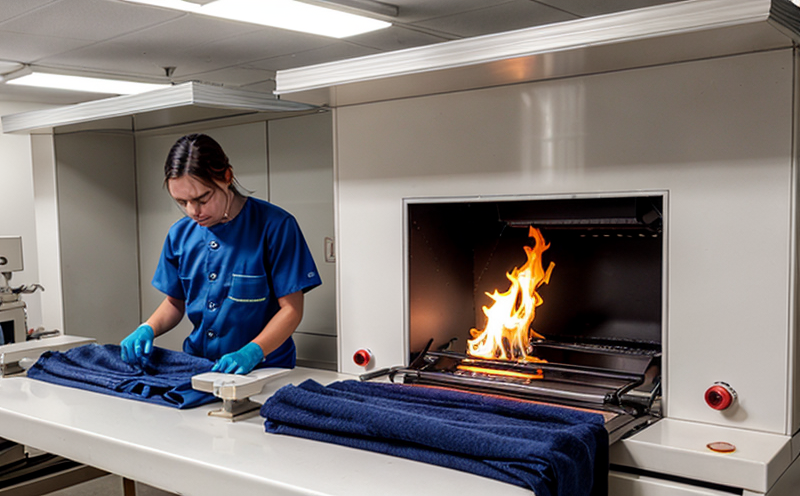ISO 6941 Textile Fabrics – Burning Behaviour – Measurement of Flammability
The ISO 6941 standard is a crucial tool in assessing the flammability behavior of textile fabrics. This method provides a standardized approach to measure the burning characteristics, ensuring that products meet international safety and regulatory requirements. Compliance with this standard is essential for manufacturers, retailers, and suppliers involved in the production of textiles used in various sectors such as apparel, furniture, and home furnishings.
The primary focus of ISO 6941 is on determining the flame spread and limiting oxygen index (LOI) of textile fabrics under specific conditions. Flame spread measures how rapidly a flame can spread across the specimen, while LOI indicates the minimum oxygen concentration required to sustain combustion. These parameters are critical in understanding the flammability potential of textiles and ensuring they meet safety standards.
The testing procedure involves placing a standardized sample of fabric onto a horizontal or vertical test rig. The sample is exposed to an ignition source for a specified duration, after which the flame spread rate is measured based on the distance traveled by the flame front. For LOI testing, the sample is placed in a closed combustion chamber where it is subjected to increasing oxygen levels until the flame goes out.
The results of these tests provide valuable insights into the fire safety performance of textile materials. By adhering to ISO 6941, manufacturers can ensure their products are safe and comply with regulatory requirements. This is particularly important for sectors like automotive textiles, where fire resistance is a key concern.
ISO 6941 is widely recognized as an authoritative standard in the field of flammability testing. Its standardized approach ensures consistency and accuracy across different laboratories worldwide, making it a reliable tool for quality assurance and compliance. Compliance with this standard not only enhances product safety but also protects consumer interests by reducing the risk of fire-related incidents.
By conducting ISO 6941 tests, companies can demonstrate their commitment to safety standards and regulatory compliance. This is especially important in industries where textile fabrics come into direct contact with consumers, such as clothing manufacturing and upholstery. The results of these tests are often required by regulatory bodies and can be used for product labeling and marketing purposes.
In conclusion, ISO 6941 plays a vital role in ensuring the fire safety performance of textile fabrics. By providing a standardized method to measure flammability characteristics, this standard helps manufacturers produce safer products that meet international standards. The consistent and reliable results obtained from these tests offer peace of mind to both manufacturers and consumers alike.
Applied Standards
The ISO 6941 standard is supported by several other international standards, including:
- ISO 5636: Textile fabrics – Ignition resistance – Test methods for textiles intended to be used in vehicles.
- ASTM E728-14: Standard test method for measuring the flame spread of textiles using a horizontal tunnel apparatus.
- EN ISO 1717: Textiles – Determination of flammability by means of a vertical test.
The application of these standards ensures consistency and reliability in testing procedures across different jurisdictions. This is particularly important for international manufacturers who need to ensure their products meet the requirements of multiple countries.
Quality and Reliability Assurance
Ensuring the quality and reliability of textile fabrics is critical, especially when it comes to flammability testing. Our laboratory adheres to strict protocols and follows international standards such as ISO 6941 to ensure accurate and reliable results.
We use state-of-the-art equipment and highly trained technicians to conduct these tests. Our facilities are equipped with the latest flame spread measurement devices, oxygen analyzers, and other necessary apparatus required for compliance testing. This ensures that every test we perform meets the highest standards of accuracy and precision.
In addition to our technical expertise, we also have robust quality control processes in place. These include regular calibration of equipment, validation of test methods, and adherence to strict safety protocols. Our commitment to quality extends beyond just the testing process; it also encompasses the integrity of our data and the reliability of our reports.
We understand that every product has unique requirements when it comes to flammability testing. That's why we offer customized testing solutions tailored to your specific needs. Whether you need basic compliance testing or more comprehensive analysis, we have the expertise and resources to meet your requirements. Our goal is not only to provide accurate results but also to help you understand the implications of those results for your product development and compliance strategy.
Use Cases and Application Examples
The ISO 6941 standard has numerous applications across different industries. Here are some key use cases:
| Industry | Purpose of Testing | Main Parameters Measured |
|---|---|---|
| Clothing Manufacturing | Ensure compliance with safety regulations for consumer products. | Flame spread rate, limiting oxygen index (LOI). |
| Furniture and Upholstery | Evaluate the fire safety of seat covers, cushions, and other fabric components. | Flame spread rate, limiting oxygen index (LOI). |
| Military Textiles | Determine the flammability characteristics of uniforms and equipment used in high-risk environments. | Flame spread rate, limiting oxygen index (LOI). |
| Automotive Industry | Assess the fire resistance of seat covers, upholstery, and other interior fabrics. | Flame spread rate, limiting oxygen index (LOI). |
In addition to these applications, ISO 6941 testing is also used in research and development (R&D) environments. It helps manufacturers identify areas for improvement in fire safety performance and develop new products that meet or exceed regulatory requirements.
- Developing safer textiles for high-risk industries like the military.
- Evaluating the effectiveness of different flame retardant treatments.
- Understanding how changes in fabric composition affect flammability characteristics.
These use cases demonstrate the versatility and importance of ISO 6941 testing across various sectors. By adhering to this standard, manufacturers can ensure their products are safe and compliant with international regulations.





